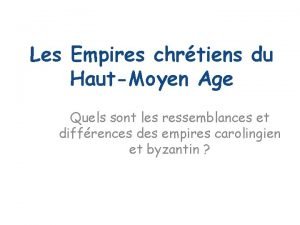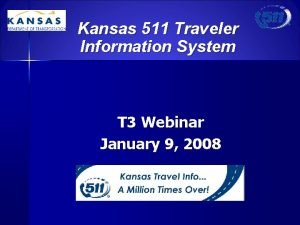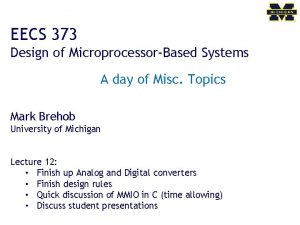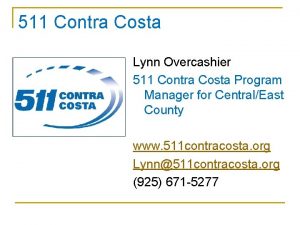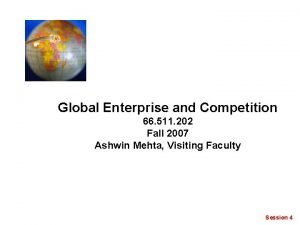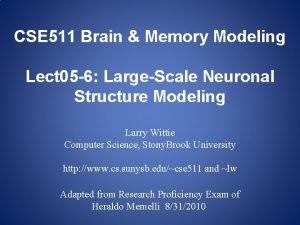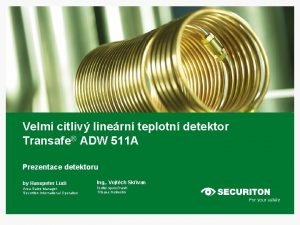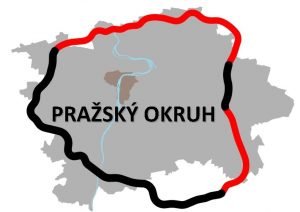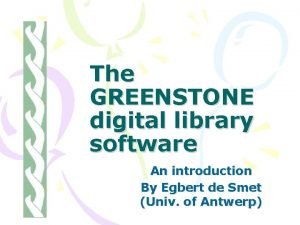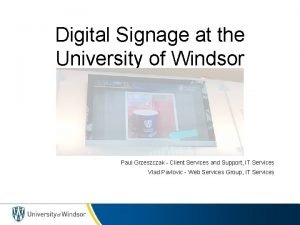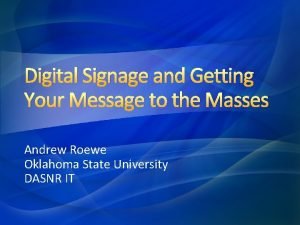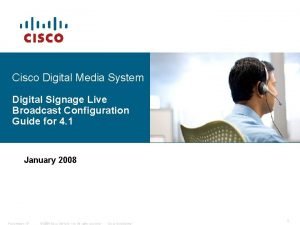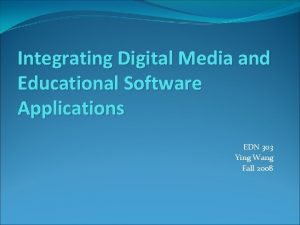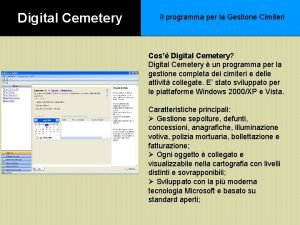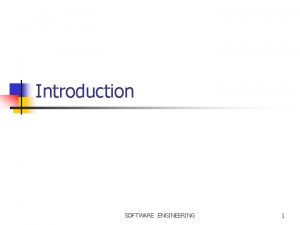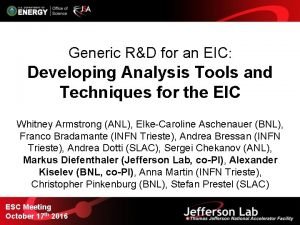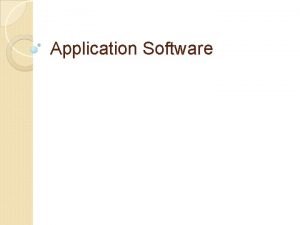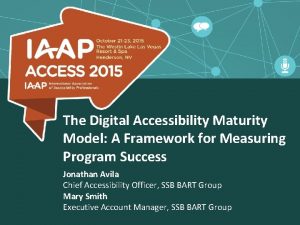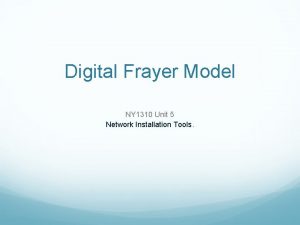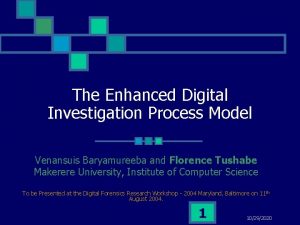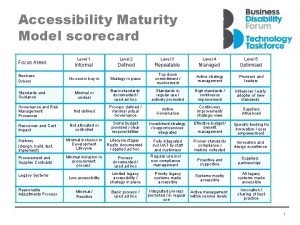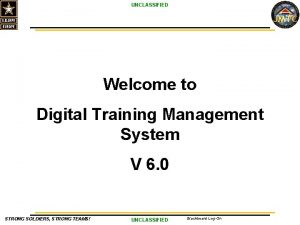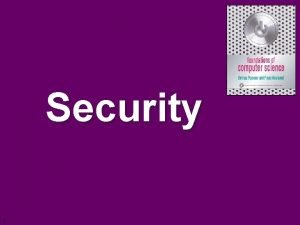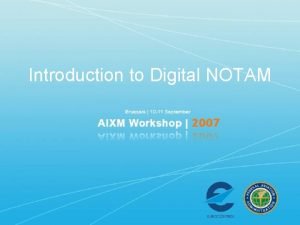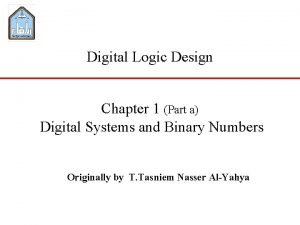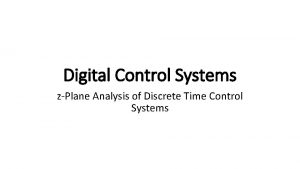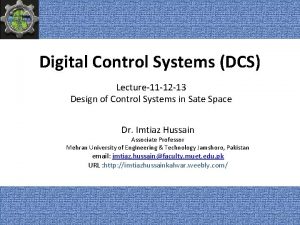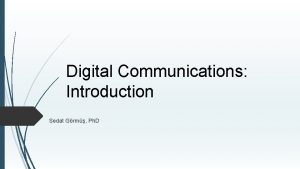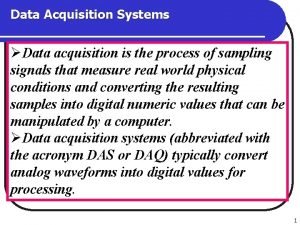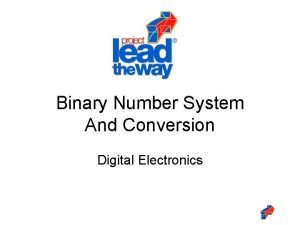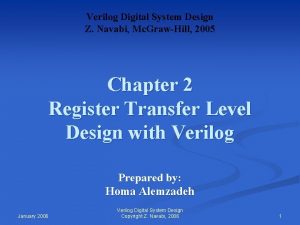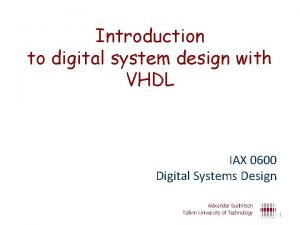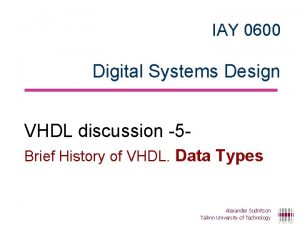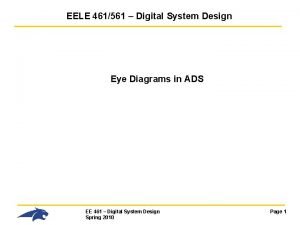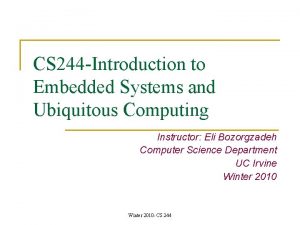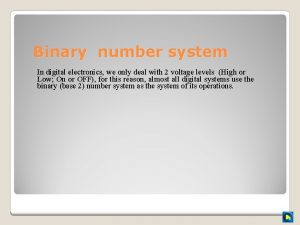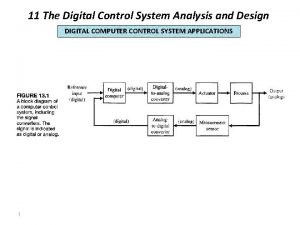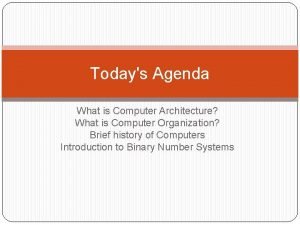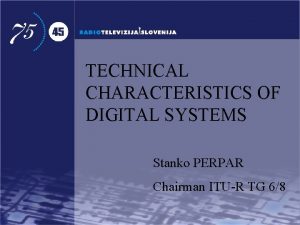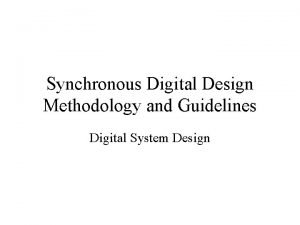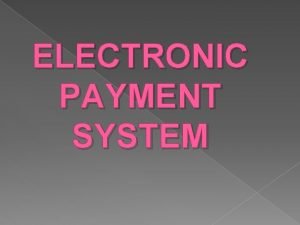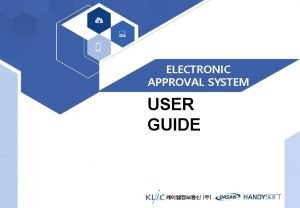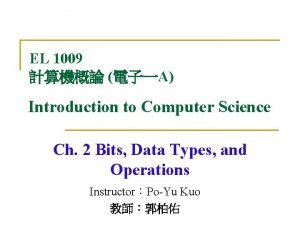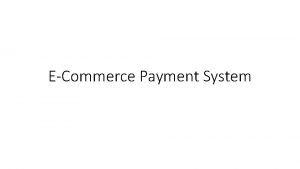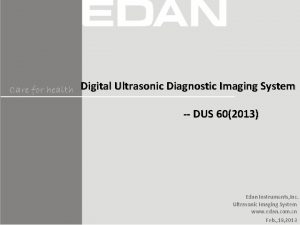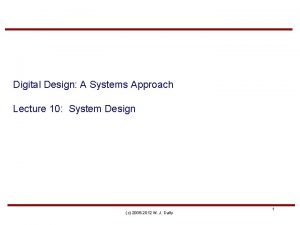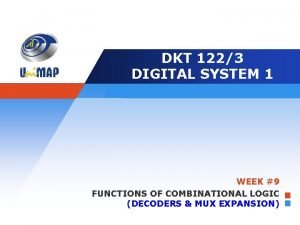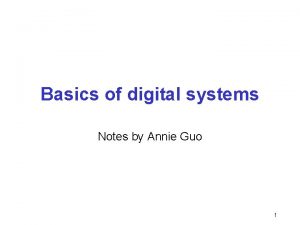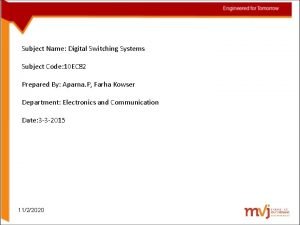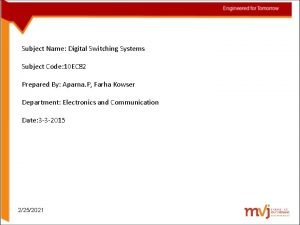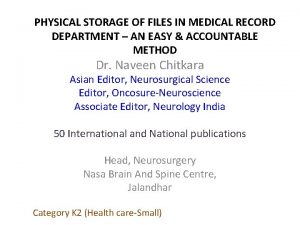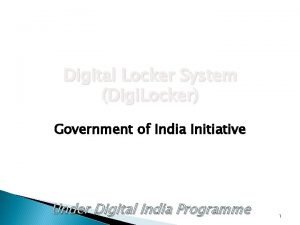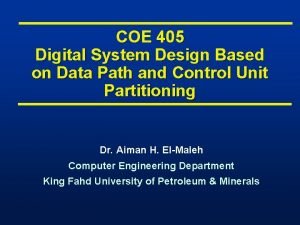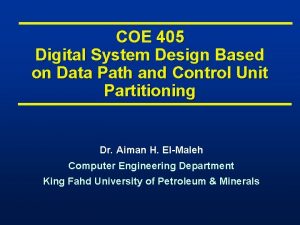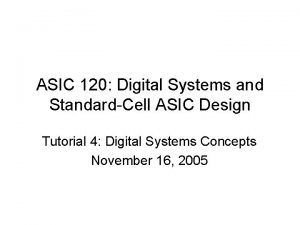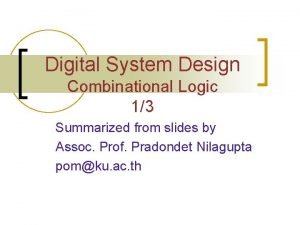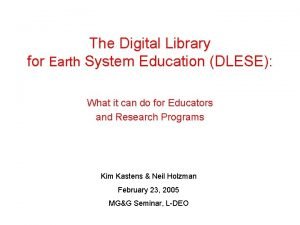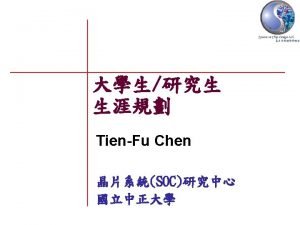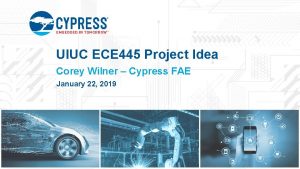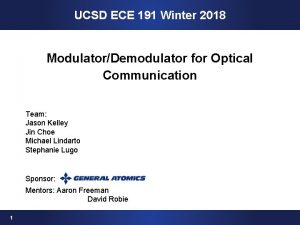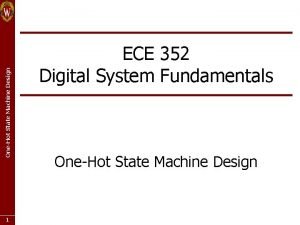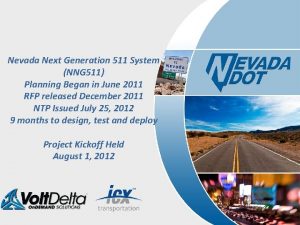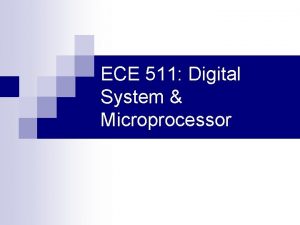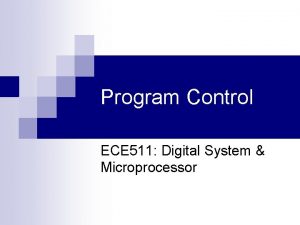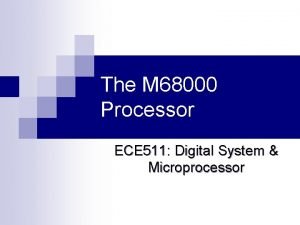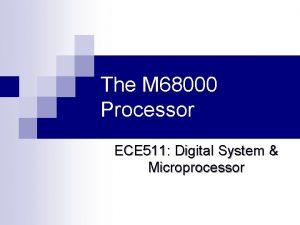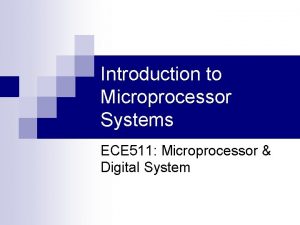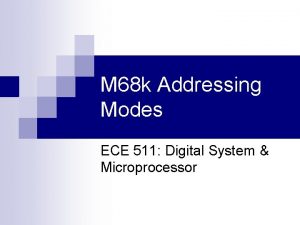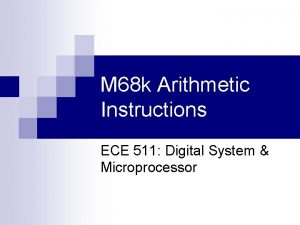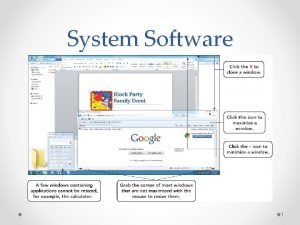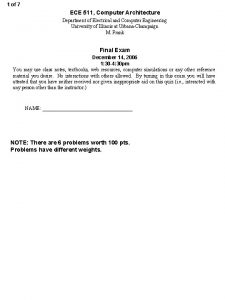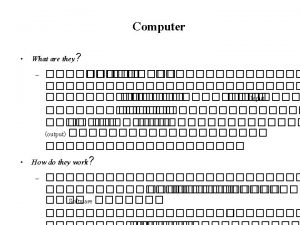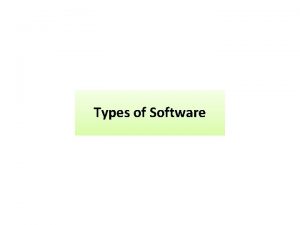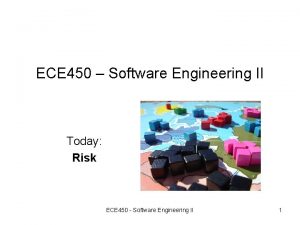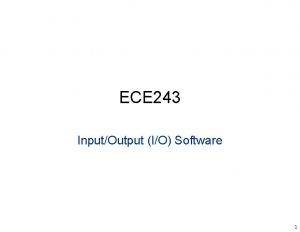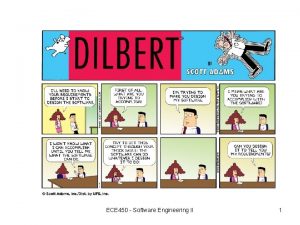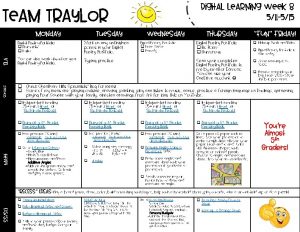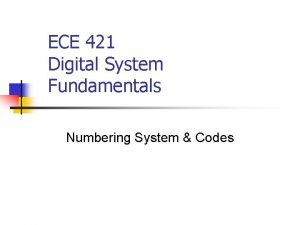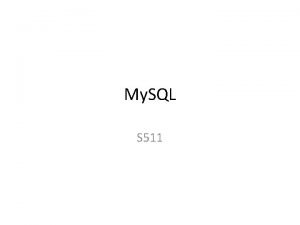68 k Software Model ECE 511 Digital System







































































































- Slides: 103

68 k Software Model ECE 511: Digital System & Microprocessor

What we are going to learn in this session: Introduction to M 68 k microprocessor. n Software model of M 68 k: n ¨ M 68 k internal architecture: Registers in M 68 k. n Their functions. n ¨ Programmer-side n view: What you will use as a programmer.

Introduction to M 68 k Microprocessor

The M 68000 Microprocessor M 68000 (M 68 k) microprocessor. n Manufactured by Motorola Semiconductors, 1979. n 16 -bit processor, but can perform 32 -bit operations. n Speed: 8 -12 MHz. n

The M 68 k Microprocessor n Very advanced compared to 8 -bit processors: ¨ 16 -bit data bus, 24 -bit address bus. ¨ Can execute instructions twice as fast. n Still available today: ¨ Simple, practical commands. ¨ Robust: can be used for many applications.

The M 68 k Microprocessor

What’s inside the M 68 k? n n n n Data Registers. Address Registers. Program Counter. Stack Pointer. Status Register. Arithmetic-Logic Unit (ALU). Instruction Register.

M 68 k Programmer Model MSB 31 16, 15 8, 7 MSB 31 LSB 0 D 1 D 2 D 3 DATA REGISTERS A 7 (USP) USER STACK POINTER 31 ADDRESS REGISTERS 31 0 PC D 4 D 5 D 6 D 7 MSB LSB 0 16, 15 PROGRAM COUNTER 0 7 CCR 16, 15 0 LSB A 0 A 1 A 2 A 3 A 4 A 5 A 6 CONDITION CODE REGISTER 31 16, 15 0 A 7’ (SSP) SUPERVISOR STACK POINTER 15 0 8, 7 CCR STATUS REGISTER SR

Data & Address Registers

Data Registers n General-purpose registers: ¨ Stores data/results for calculations. ¨ High-speed “memory” inside M 68 k. ¨ 8 registers (D 0 to D 7). ¨ 32 -bits long.

Data Registers n Able to process: ¨ 32 -bits (Long word). ¨ 16 -bits (Word). ¨ 8 -bits (Byte). ¨ 1 -bit.

How Data Registers Work - Example The CPU wants to add together 2 numbers from memory locations A and C. n Data stored into registers first, and added together. n Results stored in register. n

How Data Registers Work - Example MEMORY DATA REGISTERS (IN M 68 K) Add. Contents D 0 A $12340000 D 1 B … C $00005678 D … Contents D 2 D 3 D 4 M 68 k wants to add together contents of A and C. E D 5 F D 6 G D 7 H

How Data Registers Work - Example DATA REGISTERS (IN M 68 K) MEMORY Contents Add. Contents D 0 $12340000 A $12340000 D 1 $00005678 B … D 2 C $00005678 D 3 D … D 4 E D 5 F D 6 D 7 Step 1: M 68 k loads data from memory locations into data registers. G H

How Data Registers Work - Example DATA REGISTERS (IN M 68 K) MEMORY Add. Contents A $12340000 B … D 2 C $00005678 D 3 D … D 4 E Contents D 0 $12345678 D 1 $00005678 D 5 D 6 D 7 $12340000 + $00005678 = $12345678 Step 2: M 68 k adds together the numbers and stores them in register. Result stored in D 0. F G H

Try It Yourself START ORG $1000 A C EQU $2000 $2008 MOVE. L #$12340000, A MOVE. L #$00005678, C MOVE. L A, D 0 MOVE. L C, D 1 ADD. L D 1, D 0 END START What are the contents of addresses $2000 and $2008? What are the contents of data registers D 0 and D 1? What is the content of D 0 after execution of ADD?

Address Registers Stores memory addresses of data and instructions. n Eight registers in M 68 k. n A 0 – A 7. n A 7 (x 2) is reserved as Stack Pointer (SP). n 32 -bits long (but only uses 24 -bits). n

How Address Registers Work M 68 k wants to add Example together contents of addresses $1000 and $1008. DATA REGISTERS (IN M 68 K) ADDRESS REGISTERS (IN M 68 K) Contents MEMORY Add. Contents D 0 A 0 $1000 $12340000 D 1 A 1 $1004 … D 2 A 2 $1008 $00005678 D 3 A 3 $100 C … D 4 A 4 $1010 D 5 A 5 $1014 D 6 A 6 $1018 D 7 A 7 $101 C

How Address Registers Work The addresses $1000 and Example $1008 are loaded into Address Registers. DATA REGISTERS (IN M 68 K) ADDRESS REGISTERS (IN M 68 K) Contents MEMORY Add. Contents D 0 A 0 $1000 $12340000 D 1 A 1 $1008 $1004 … D 2 A 2 $1008 $00005678 D 3 A 3 $100 C … D 4 A 4 $1010 D 5 A 5 $1014 D 6 A 6 $1018 D 7 A 7 $101 C

How Address Registers Work Example DATA REGISTERS (IN M 68 K) ADDRESS REGISTERS (IN M 68 K) Contents The values of A 0 and A 1 are sent to memory. MEMORY Add. Contents D 0 A 0 $1000 $12340000 D 1 A 1 $1008 $1004 … D 2 A 2 $1008 $00005678 D 3 A 3 $100 C … D 4 A 4 $1010 D 5 A 5 $1014 D 6 A 6 $1018 D 7 A 7 $101 C

How Address Registers Work Example DATA REGISTERS (IN M 68 K) ADDRESS REGISTERS (IN M 68 K) Contents MEMORY Contents Add. Contents D 0 $12340000 A 0 $1000 A $12340000 D 1 $00005678 A 1 $1008 B … D 2 A 2 C $00005678 D 3 A 3 D … D 4 A 4 E D 5 A 5 F D 6 D 7 M 68 k A 6 loads data from A 7 memory locations into data registers. G H

How Address Registers Work Example DATA REGISTERS (IN M 68 K) MEMORY Add. Contents A $12340000 B … D 2 C $00005678 D 3 D … D 4 E Contents D 0 $12345678 D 1 $00005678 D 5 D 6 D 7 $12340000 + $00005678 = $12345678 Step 2: M 68 k adds together the numbers and stores them in register. Result stored in D 0. F G H

Try It Yourself START ORG $2000 LEA $1000, A 0 $1008, A 1 MOVE. L #$12340000, (A 0) MOVE. L #$00005678, (A 1) MOVE. L (A 0), D 0 MOVE. L (A 1), D 1 ADD. L END START D 1, D 0 What are the contents of addresses in A 0 and A 1? What are the contents of data registers D 0 and D 1? What is the content of D 0 after execution of ADD?

Address Register vs. Data Register Comparison Address Register Data Register Size 32 -bit Total 7 (1 reserved) 8 Designation A 0 to A 6 (A 7 reserved) D 0 to D 7 Data size Word, Long Byte, Word, Long Instructions to access Special instructions General instructions Purpose Store addresses only Store data only

Program Counter

Program Counter (PC) Instructions must occur in correct sequence for program to run properly. n PC makes sure this happens: n ¨ Special-purpose register inside CPU. ¨ Keeps track of address of next instruction. ¨ 32 -bits: can point to any location in memory.

Remember this cycle? Reset Fetch Decode Execute

Fetch – Step 1 CPU Memory Control Instruction Register Data Registers CPU gets instruction address from PC Program Counter $1000 $1001 $1002 Instruction #1 $1003 $1004 $1005 $1006 $1007 $1008 $1009 Instruction #2 Instruction #1 Instruction #2 Empty Data #1 Data #2 Data #3

Fetch – Step 2 CPU Memory Address Bus Control $1000 Instruction Register Data Registers Program Counter $1000 CPU outputs instruction address through Address Bus $1000 $1001 $1002 Instruction #1 $1003 $1004 $1005 $1006 $1007 $1008 $1009 Instruction #2 Instruction #1 Instruction #2 Empty Data #1 Data #2 Data #3

Fetch – Step 3 CPU Memory Data Bus Control Instruction #1 Instruction Register Data Registers Program Counter $1000 Memory gets the instruction and sends in to CPU using Data Bus. $1000 $1001 $1002 Instruction #1 $1003 $1004 $1005 $1006 $1007 $1008 $1009 Instruction #2 Instruction #1 Instruction #2 Empty Data #1 Data #2 Data #3

Fetch – Step 4 CPU Memory Control Instruction Register Instruction #1 Data Registers CPU stores instruction in Instruction Register Program Counter $1000 $1001 $1002 Instruction #1 $1003 $1004 $1005 $1006 $1007 $1008 $1009 Instruction #2 Instruction #1 Instruction #2 Empty Data #1 Data #2 Data #3

Fetch – Step 5 CPU Memory Control Instruction Register Instruction #1 Data Registers Program Counter $1002 After instruction has been loaded, CPU updates Program Counter. $1000 $1001 $1002 Instruction #1 $1003 $1004 $1005 $1006 $1007 $1008 $1009 Instruction #2 Instruction #1 Instruction #2 Empty Data #1 Data #2 Data #3

Program Counter (PC) n Once M 68 k fetches instruction from memory, it automatically increments PC. ¨ Just before M 68 k starts to execute the current instruction. n PC always points to the next instruction during execution of current instruction.

Program Counter (PC) Before M 68 k can start executing a program, PC has to be loaded with address of its first instruction. n During start-up, PC must be loaded with a number: n ¨ First instruction the M 68 k has to execute. ¨ Usually at simple location – $0000000.

Program Counter (PC) PC can be loaded with new value to “jump” over instructions. n When the PC is modified, new instruction is taken from new PC value, not the address in sequence. n Can use this technique in subroutines, exceptions and branches. n

Try It Yourself START ORG $1000 MOVE. B ADD. B D 0, D 1 D 3, D 4 D 1, D 4 END START What are the contents of memory address starting from $1000? Execute the program step by step. Notice that the value of PC changes automatically after each instruction.

* Normal execution PC loaded with $1000, execution starts with this location.

Instructions executed one line at a time.



* Using Branch command

PC goes to next instruction Jumps to $1012 because of branch command.


PC loaded with $1006, jumps here.

Stack Pointer

Software Stack n Sometimes, registers not enough to store data: ¨ Only 8 data registers available. Solution: reserve part of memory for storing data – software stack. n Data can be stored/retrieved by pushing/popping. n

Software Stack n Stacks are usually used to store: ¨ Data register values. ¨ Program Counter. ¨ Status Register. ¨ Other information. n n Stacks operate on LIFO basis (Last In First Out). Pushes (puts) items on stack and pops (takes) in reverse order.

The Software Stack - Push $1234 $5678 D 0 $12345678 D 1 $00003432 D 2 … D 3 … D 4 … D 5 … D 6 … D 7 … $0000 $3432 *All the registers are full, SP but we want to use D 0 and D 1 for something else. So, D 0 and D 1 pushed onto stack.

The Software Stack – After Push D 0 Stack D 1 SP D 2 $1234 D 3 $5678 D 4 $0000 D 5 $3432 D 6 D 7 *D 0 and D 1 can now be cleared and used for other data. SP set as address to uppermost layer.

The Software Stack - Pop $1234 $5678 $0000 D 0 $12345678 D 1 $00003432 D 2 $3432 D 3 D 4 D 5 D 6 SP *When we are done, pop the stack back into D 0 and D 1. SP is restored to original value. D 7

Stack Pointer (SP) n Stack pointer: special register to keep record of stack use: ¨ Keeps track of top-most stack position. A 7 used to store SP. n 32 -bits: large enough to address all memory locations. n

Stack Pointer in Action – Moving Data into Stack MOVE. L #$11112222, D 0, -(A 7) *initial SP at $1000 SP (inside M 68 k): $0 FFC $0 FF 8 $0 FFA NEW SP VALUE OLD SP VALUE $0 FFC 1111 $0 FFE 2222 $1000 Not Filled

Stack Pointer in Action – Moving Data into Stack MOVE. L #$33334444, D 0, -(A 7) *initial SP at $1000 SP (inside M 68 k): $0 FF 8 *SP always keeps track of NEW upper-most location in stack SP VALUE OLD SP VALUE $0 FF 8 3333 $0 FFA 4444 $0 FFC 1111 $0 FFE 2222 $1000 Not Filled

Stack Pointer in Action – Getting Data Back from Stack MOVE. L (A 7)+, D 0 SP (inside M 68 k): D 0: $0 FFC OLD SP VALUE NEW SP VALUE $33334444 $0 FF 8 Popped back to D 0 $0 FFA Popped back to D 0 $0 FFC 1111 $0 FFE 2222 $1000 Not Filled

Try It Yourself START ORG $1000 MOVE. L #$11112222, D 0 MOVE. L #$33334444, D 1 MOVE. L D 0, -(A 7) MOVE. L D 1, -(A 7) * PUSH MOVE. L #$AAAABBBB, D 0 MOVE. L #$CCCCDDDD, D 1 MOVE. L (A 7)+, D 0 END START *POP

Status Register

Status Register n n n Special purpose register, 16 -bits wide. Stores important control and status bits of arithmetic calculations. Consists of: ¨ Trace flag. ¨ Supervisor flags. ¨ Interrupt mask flags. ¨ Condition Code Register (CCR) flags.

The Status Register T S I 2 I 1 I 0 T = Trace Flag. S = Supervisor Flag. I 2, I 1, I 0 = Interrupt Mask Flags. X = Extend Flag. N = Negative Flag. Z = Zero Flag. V = Overflow Flag. C = Carry Flag. X N Z CCR V C

Status Register – Trace Bit n Trace bit (T) used for program tracing: ¨ Used to debug programs. ¨ When trace is on, the program is executed one line at a time. ¨ Waits for user input before going to next line. ¨ T = 1, enabled. T = 0, disabled.

Status Register – Supervisor Bit Used to store privilege state of M 68 k. n Two states defined: n ¨S = 1, Supervisor mode. ¨ S = 0, User mode. n Controls access to critical system instructions and data.

Why do we need User/Supervisor modes? n In any M 68 k system, there are: ¨ Critical system data that must not be changed by inexperienced users. These data are stored in special memory locations. ¨ Potentially destructive instructions that cannot be executed by inexperienced users. n n Reset system. Halt system. Edit Status Register, Stack Pointer values. User/SV modes limits access by not allowing certain actions if users does not have SV privileges.

Supervisor vs. User Mode Property User Mode Supervisor Mode Activated when S=0 S=1 Memory Access to only user memory locations. Access to both user and supervisor memory locations. Instruction Set Limited instruction set. Unlimited instruction set. Can modify SR/SP? False. True. Stack pointer User Stack Pointer*. Supervisor Stack Pointer*. *A 7 (SP) actually has two registers, SSP and USP.

Status Register – Interrupt Mask Bits (IMB) n 3 -bits (I 2, I 1, I 0) as interrupt masks: ¨ Stores interrupt levels from 000 to 111. ¨ 000 (0) is lowest priority, least important. ¨ 111 (7) is highest priority, most important. ¨ Interrupt request compared to IMB to determine whether it should be executed.

What are interrupts? n Allows M 68 k to prioritize processing: ¨ More important tasks executed first. ¨ Less important tasks executed later. n Requested by external device: ¨ Asks to be serviced. ¨ Compare priority to IMB. ¨ If higher than IMB, update IMB and service interrupt. ¨ If request lower than IMB, request stored, executed later.

Interrupt Example External Peripheral M 68 k is executing instructions normally. 1 4 T M 68 k compares interrupt level to SR. S I 2 I 1 I 0 XNZVC 2 External peripheral has important task for M 68 k. 3 External peripheral asks for attention from M 68 k.

M 68 k 5 If external interrupt higher than current. 5 If external interrupt lower than current. 6 Update interrupt bits, save important data into stack. 6 Wait for higher-level interrupt being handled. 7 Handle interrupt, restore interrupt bits. 8 Pop stack, resume normal execution.

Condition Code Register (CCR)

Condition Code Register (CCR) n n n Used to store status of evaluated conditions. Final 5 -bits of SR. Bits in CCR: ¨ X: Stores extra bit for arithmetic shifts. ¨ N: Whether the result is negative. ¨ Z: Whether the result is zero. ¨ V: Whether an arithmetic overflow has occurred. ¨ C: Whether a carry/borrow has occurred.

X: Extend Bit n Purpose: ¨ To n allow rotate and shift operations: Stores the extra shifted bit during rotation. ¨ For multi-precision arithmetic in BCD operations. ¨ Usually set according to C.

X Example – Rotate MOVE. B ROXL. B D 0. B = #$9 C, D 0 #1, D 0 * Assuming X = 0 before ROXL 1 0 0 1 1 1 0 0 X=0 X=1 0 0 1 1 1 0 0 0 X=1 C set as well

Try It Yourself START ORG $1000 MOVE. B #$9 C, D 0 ROXL. B #1, D 0 END START

X Example – Arithmetic Shift ASL. B D 0. B = #1, D 0 1 0 0 1 1 1 0 0 0 C=1 X=1 *X keeps extra bit, C set as well 0

Try It Yourself START ORG $1000 MOVE. B #$9 C, D 0 ASL. B #1, D 0 END START

X Example – BCD Operation D 0 = $00000099 D 1 = $00000099 X = 1 before execution ABCD D 0, D 1. B = 1 0 0 9 1 1 99 99 1 198 + + 0 0 9 1 X/C = 1 (result > 99). Z = clear since result non-zero. N, V = undefined

Try It Yourself START ORG $1000 MOVE. B #$99, D 0 #$99, D 1 ABCD D 0, D 1 END START

N – Negative Bit Purpose: to test whether the result is negative. n Does this by examining the MSB: n ¨ In 2’s complement, MSB is sign bit. ¨ If MSB = 0, N = 0 (not negative). ¨ If MSB = 1, N = 1 (negative).

N Example MOVE. B n SUB. B n $9 C = #0, D 0 #100, D 1, D 0 1 0 0 D 0 = $00 (0) D 1 = $64 (100) D 0 = 0 – 100 = $9 C (-100) 1 1 1 MSB = 1, N = 1 0 0

Try It Yourself START ORG $1000 MOVE. B #0, D 0 MOVE. B #100, D 1 SUB. B D 1, D 0 END START

Z – Zero Bit Purpose: to test whether the result is zero. n Does this by examining all active bits. n ¨ If all active bits = 0, Z = 1 (is zero). ¨ If not all active bits = 0, Z = 0 (not zero).

Z Example MOVE. L n MOVE. W #$FFFF, D 0 #$0000, D 0 n Initial D 0 = F F F F Final D 0 = F F 0 0 * Only W is tested, since. W was used N=1

Try It Yourself START ORG $1000 MOVE. L #$FFFF, D 0 MOVE. W #$0000, D 0 END START

Z Example MOVE. L n SUB. B #$FFFF, D 0 #$FF, D 0 n Initial D 0 = F F F F Final D 0 = F F F 0 0 * Only B is tested, since. B was used N=1

Try It Yourself START ORG $1000 MOVE. L #$FFFF, D 0 SUB. B #$FF, D 0 END START

V – Overflow Bit n Checks whether sign bit is changed as a result of arithmetic operation. ¨ Set when arithmetic operation changes MSB. ¨ Only few instructions can change V. ¨ Check with M 68 k instruction reference.

V – Overflow Bit n Usually, V is set when: ¨ MSB changes from 0 1. ¨ MSB changes from 1 0. ¨ Divide overflow occurs.

V- Overflow Bit In ADD, SUB and CMP, V is modified differently. n For ADD, SUB & CMP: n ¨P +P=N ¨N + N = P ¨P – N = N ¨N – P = P * P = Positive Number (MSB = 0) N = Negative Number (MSB = 1)

V Example n n n + MOVE. B #$41, D 0 MOVE. B #$46, D 1 ADD. B D 1, D 0 = 65 + 70 2’s complement D 0. B = 0 1 0 0 0 1 +65 D 1. B = 0 1 0 0 0 1 1 0 +70 1 0 0 1 1 1 -121? New D 0. B = V=1

Try It Yourself START ORG $1000 MOVE. B #$41, D 0 #$46, D 1 ADD. B D 1, D 0 END START

V Example n n n + MOVE. B #$DE, D 0 MOVE. B #$9 F, D 1 ADD. B D 1, D 0 = -34 + (-97) 2’s complement D 0. B = 1 1 0 -34 D 1. B = 1 0 0 1 1 1 -97 New D 0. B = 0 1 1 1 0 1 V=1 +125?

Try It Yourself START ORG $1000 MOVE. B #$DE, D 0 #$9 F, D 1 ADD. B D 1, D 0 END START

V Example n n n - MOVE. B #$41, D 0 MOVE. B #$87, D 1 SUB. B D 1, D 0 = +65 – (-121) 2’s complement D 0. B = 0 1 0 0 0 1 +65 D 1. B = 1 0 0 1 1 1 -121 New D 0. B = 1 0 1 1 1 0 V=1 -70?

Try It Yourself START ORG $1000 MOVE. B #$41, D 0 #$87, D 1 SUB. B D 1, D 0 END START

V Example n n n - MOVE. B #$95, D 0 MOVE. B #$7 F, D 1 SUB. B D 1, D 0 = (-107) – 127 2’s complement D 0. B = 1 0 0 1 0 1 -107 D 1. B = 0 1 1 1 1 +127 0 0 0 1 1 0 +22? New D 0. B = V=1 * Update slide

Try It Yourself START ORG $1000 MOVE. B #$95, D 0 #$7 F, D 1 SUB. B D 1, D 0 END START

DIVU Example - Overflow D 0 = $00186 A 1 (100, 001 decimal) D 1 = $0000001 (1 decimal) DIVU D 1, D 0 100, 001 / 1 = 100, 001 = $186 A 1 Quotient Remainder Decimal 100, 001 0 Hex $186 A 1 $0000 New D 0 = 0 0 0 1 8 6 A 1 Quotient overflowed to remainder. V = 1 (divide overflow)

C – Carry Bit n Purpose: to test whether a borrow/carry has occurred: ¨ Carry occurs when addition results are “carried forward”. ¨ Borrow occurs when subtraction results are “borrowed”. n Does this by examining the results of addition/subtraction operations.

C Example - Carry n n n MOVE. B ADD. B #$FF, D 0 #$FF, D 1, D 0. B = 1 1 1 1 + D 1. B = 1 1 1 1 0 1 Carry occurred, C = 1

Try It Yourself START ORG $1000 MOVE. B #$FF, D 0 #$FF, D 1 ADD. B D 1, D 0 END START

C Example - Borrow n n n MOVE. B SUB. B - #$12, D 0 #$34, D 1, D 0 = 0 0 0 1 0 D 1 = 0 0 1 1 1 1 0 Borrow occurred, C = 1

Try It Yourself START ORG $1000 MOVE. B #$12, D 0 #$34, D 1 SUB. B D 1, D 0 END START

Conclusion

Conclusion n Data registers store data for manipulation. Address registers can only store address. Status register hold various status and control bits during M 68 k operations: ¨T actives trace mode. ¨ S activates supervisor mode. ¨ IMB stores level of serviced interrupt. ¨ CCR store status each instruction performed. ¨ Remember how conditions tested, results.

The End Please read: Antonakos, pg. 59 – 61. Gilmore, 71 – 98.
 Royaume de clovis en 511
Royaume de clovis en 511 Kansas 511
Kansas 511 Eecs 373
Eecs 373 Nnn-511
Nnn-511 Kev 775
Kev 775 511
511 Goroo trip planner
Goroo trip planner Cse 511
Cse 511 Adw 511
Adw 511 Circulation 511
Circulation 511 Stavba 511
Stavba 511 Sokp 511
Sokp 511 Chapter 3 skills and applications
Chapter 3 skills and applications Is an os system software or application software
Is an os system software or application software Apa yang dimaksud dengan warga digital
Apa yang dimaksud dengan warga digital Digital goods ecommerce
Digital goods ecommerce Digital data digital signals
Digital data digital signals Digital data transmission
Digital data transmission E-commerce: digital markets, digital goods
E-commerce: digital markets, digital goods Data encoding techniques in computer networks
Data encoding techniques in computer networks Luxembourg digital innovation hub
Luxembourg digital innovation hub Unique features of digital markets
Unique features of digital markets Features of greenstone digital library software
Features of greenstone digital library software Webconverger competitors
Webconverger competitors Digital signage ppt
Digital signage ppt Cisco digital signage
Cisco digital signage What is digital media software
What is digital media software Digital cemetery
Digital cemetery Greenstone digital library software
Greenstone digital library software Dynamic digital signage software
Dynamic digital signage software Concentric zone model
Concentric zone model Is earth open or closed system
Is earth open or closed system Respiratory system circulatory system digestive system
Respiratory system circulatory system digestive system Software maintenance in software engineering ppt
Software maintenance in software engineering ppt Frank maurer
Frank maurer Improving software economics in project management
Improving software economics in project management Software engineer vs software developer
Software engineer vs software developer What is software metrics in software engineering
What is software metrics in software engineering Generic software vs custom software
Generic software vs custom software Difference between student software and industrial software
Difference between student software and industrial software Example of software crisis
Example of software crisis Software measurement and metrics in software engineering
Software measurement and metrics in software engineering Eic software software review
Eic software software review Real time software design in software engineering
Real time software design in software engineering Software design fundamentals in software engineering
Software design fundamentals in software engineering Examples of graphics and multimedia software
Examples of graphics and multimedia software Digital accessibility maturity model
Digital accessibility maturity model Spatial and temporal redundancy in digital image processing
Spatial and temporal redundancy in digital image processing Navigating the digital landscape
Navigating the digital landscape Variable length coding in digital image processing
Variable length coding in digital image processing Image formation model in digital image processing ppt
Image formation model in digital image processing ppt Digital frayer model
Digital frayer model Idip model
Idip model Accessibility maturity model
Accessibility maturity model Dtms help desk
Dtms help desk A digital signature needs a private key system
A digital signature needs a private key system Us digital notam system
Us digital notam system Whats an analog
Whats an analog Digital logic design number system
Digital logic design number system Zero order hold laplace
Zero order hold laplace Regulator control system
Regulator control system Components of digital communication system
Components of digital communication system Digital data acquisition system block diagram
Digital data acquisition system block diagram Number system in digital electronics
Number system in digital electronics Digital camera embedded system
Digital camera embedded system Digital systems design using verilog
Digital systems design using verilog Pld
Pld Digital system design
Digital system design Digital system design
Digital system design Sarpio oriflame
Sarpio oriflame Embedded system in digital camera
Embedded system in digital camera Binary number system in digital electronics
Binary number system in digital electronics Digital control
Digital control Number system
Number system Characteristics of digital system
Characteristics of digital system Synchronous design methodology
Synchronous design methodology Bdl authentification
Bdl authentification Management information system managing the digital firm
Management information system managing the digital firm Eps card meaning
Eps card meaning Electronic document approval
Electronic document approval Mathematic
Mathematic Digital accumulating balance payment system
Digital accumulating balance payment system Digital ultrasonic diagnostic imaging system
Digital ultrasonic diagnostic imaging system Digital design a system approach
Digital design a system approach Digital system logo
Digital system logo Digital system notes
Digital system notes Tanah genting kra
Tanah genting kra Digital switching system
Digital switching system Digital switching system
Digital switching system Terminal digit filing example
Terminal digit filing example Digital system
Digital system Digital locker system
Digital locker system Introduction to analog and digital control systems
Introduction to analog and digital control systems Asmd chart for digital system design
Asmd chart for digital system design Asm chart for traffic light controller
Asm chart for traffic light controller Asic design tutorial
Asic design tutorial Digital system design
Digital system design Introduction to analog and digital control systems
Introduction to analog and digital control systems Dlese
Dlese Digital camera embedded system
Digital camera embedded system Is 445 uiuc
Is 445 uiuc Ece 191 ucsd
Ece 191 ucsd One hot state assignment
One hot state assignment Ece okay
Ece okay
